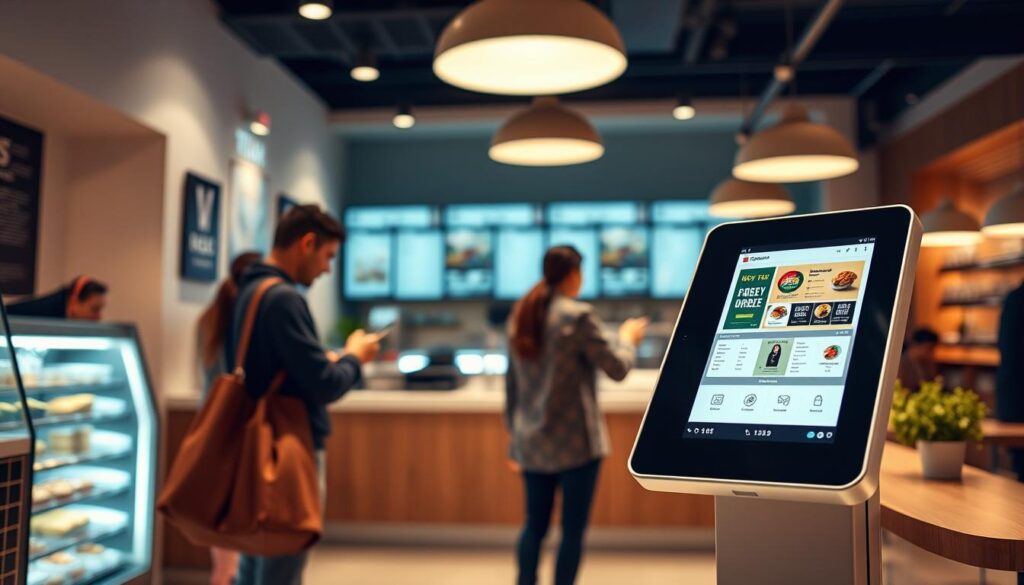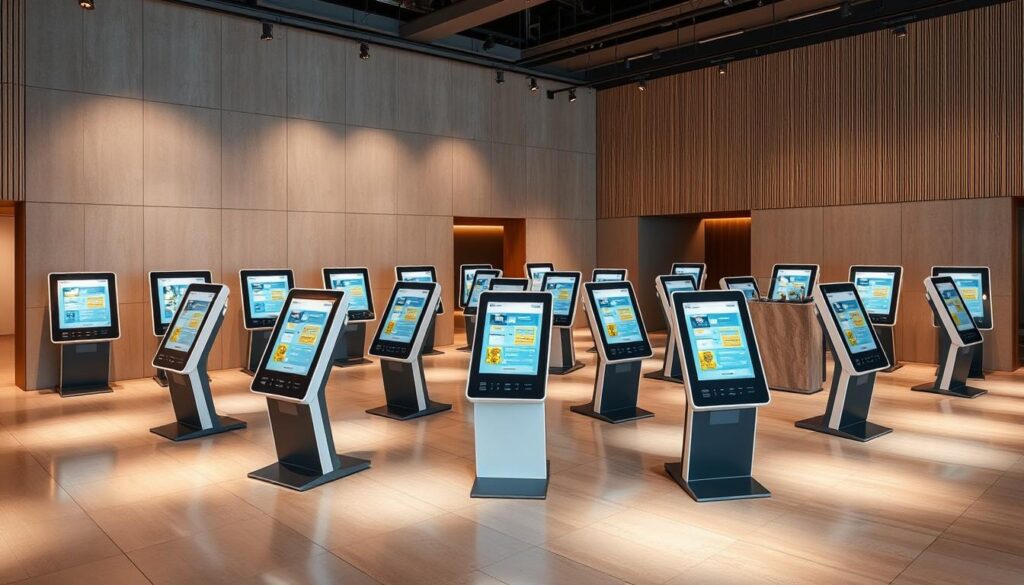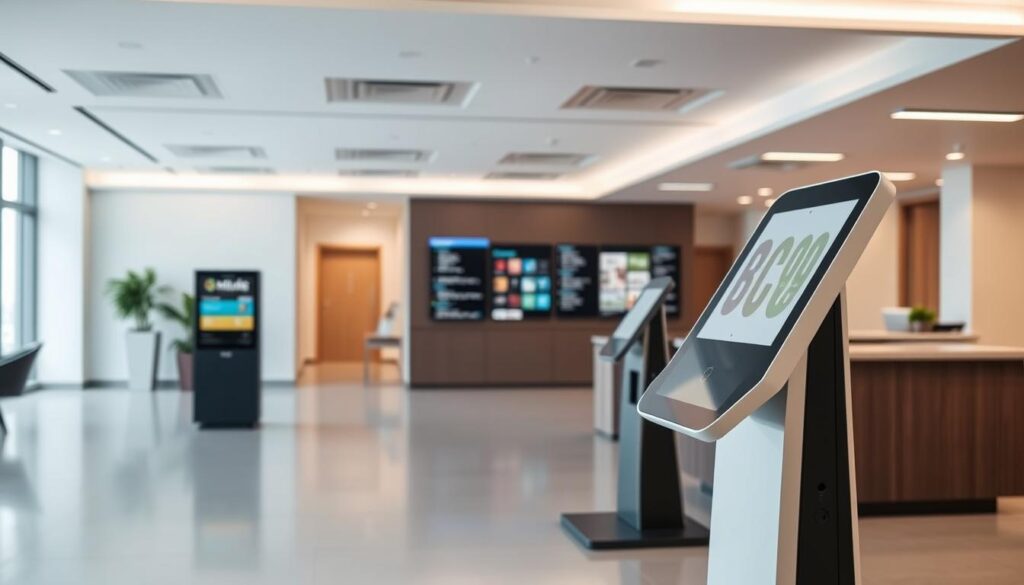The world is seeing a big jump in demand for digital ordering kiosks. The self-service kiosk market is set to reach $43.65 billion by 2028. RBR Data Services predicts nearly 700,000 kiosks globally, showing a move towards tech-based customer experiences.
These systems make tasks like taking orders and making payments quicker. They help businesses save money and serve customers faster.

Companies using kiosk ordering systems save 20-30% on labor costs. They also see a 20% boost in order accuracy. More than 70% of customers like using self-service, leading to a 150% return on investment in just a year.
These tools help cut down wait times and increase upselling through personalized menus. They meet the growing need for tech in customer interactions.
Understanding the Digital Ordering Revolution
Self-service kiosks and online ordering kiosks are changing how we interact with businesses. They let customers order, customize, and pay digitally. This change is part of a bigger trend towards using technology for convenience.
What Are Digital Ordering Kiosks?
These devices use touchscreens and software to make transactions easier. In restaurants, they let customers pick menu items and add toppings. They also show nutritional information.
Online ordering kiosks connect with backend systems. This helps update inventory and loyalty programs. They are designed to be easy to use, supporting many languages and being accessible to all.
The Evolution of Self-Service Technology
Self-service technology started with ATMs and retail scanners. Now, it includes AI, QR code menus, and mobile app integration. The pandemic made people want contactless options even more.
Today, kiosks offer personalized suggestions and real-time order tracking. They’ve come a long way from their simple beginnings.
Why Businesses Are Adopting Kiosk Technology
Businesses adopt kiosks for cost savings, efficiency, and customer demand. A 2023 study found kiosk users see up to 30% faster orders and 15% higher average ticket sizes. Here are some real-world examples:
| Company | Key Benefits | Outcome |
|---|---|---|
| McDonald’s | Reduced staff workload | 19% sales increase in kiosk-enabled locations |
| Wendy’s | Personalized upsell prompts | Average order value rose by 22% |
| Domino’s | Integrated online kiosk systems | 25% faster order accuracy |
These examples show how self-service kiosks lead to real benefits. They save on labor and boost customer loyalty. As technology advances, kiosks become key for businesses to stay ahead.
Key Benefits of Implementing Ordering Kiosks in Your Business
Businesses that use digital ordering kiosks see big changes. They get better at running their operations, serving customers, and making more money. These systems make things run smoother, helping businesses stand out in a crowded market.
“75% of customers prefer self-service options to save time.” — McKinsey & Company
Here are the main benefits:
- Cost Efficiency: Studies by Forrester show businesses can save up to 30% on labor costs. This is because staff can focus on other important tasks, not just taking orders.
- Revenue Growth: Restaurants with food ordering kiosks see their average order value go up by 20–30%. This is thanks to upselling and personalized suggestions.
- Customer Satisfaction: Kiosks make lines shorter by 30% during busy times. This makes customers happier and more likely to come back.
| Traditional Method | With Digital Kiosks |
|---|---|
| Manual errors in orders | 95% accuracy in order fulfillment |
| High staffing needs | 30% fewer frontline staff required |
| Static menu options | Dynamic upselling suggestions boosting sales |
There are also environmental perks. Food ordering kiosks cut down on paper waste by getting rid of physical menus and receipts. They also help businesses understand what customers like, leading to better menus and less food waste. With a market size of $27.4 billion in 2022, these systems are a smart choice for businesses looking to stay ahead in the digital world.
Types of Digital Ordering Kiosks for Different Business Needs
Today’s businesses use digital kiosks to make things easier and better for customers. These tools fit different needs, from quick-service restaurants to hospitals. They are easy to use.

65% of customers prefer restaurants with self-service kiosks, leading to more visits. (Source: Forbes)
Restaurant and Food Service Kiosks
- Quick-service restaurants (QSRs) use touch screen kiosks to reduce mistakes by 20% and increase sales by 15% with upselling.
- Fine dining and casual places use tablets for ordering at tables, making service more personal.
Retail Self-Service Kiosks
- Self-checkout stations shorten lines, and product info kiosks in malls or big-box stores help find items quickly.
- Interactive displays in grocery stores show seasonal items or promotions, boosting sales and time spent shopping.
Healthcare Check-In Kiosks
- Hospitals and clinics use kiosks for patient registration, cutting wait times by up to 40% and freeing staff.
- Secure biometric features ensure privacy while making intake faster.
Hospitality and Entertainment Kiosks
- Hotels use touch screen kiosks for self-check-in, and theme parks use them for tickets and updates on wait times.
- AR-enabled kiosks in museums or airports offer interactive demos or help with navigation, making visits more engaging.
Choosing the right kiosk depends on what you want to achieve. Restaurants benefit from restaurant kiosks that make ordering easier. Retailers focus on easy-to-use interfaces to increase sales. Easy-to-use kiosks lead to more adoption, as 70% of diners prefer them over lines. Investing in the right solutions boosts ROI and customer happiness.
Strategic Implementation: Integrating Kiosks into Your Operations
Integrating self-service kiosks into your business needs a solid plan. First, check your workflows and how customers move through your space. Look for spots where interactive kiosks can make things smoother. Start with a small test to see how it works and get feedback.
Taco Bell tested their kiosks first and then added them to 6,500 places.

Hardware and Software Selection
- Square Kiosk hardware starts at $149, with flexible payment plans like $14/month over 12 months.
- Choose iPad-compatible models like the 10th-gen or iPad Pro 11-inch for durability and scalability.
- Ensure software integrates seamlessly with existing POS systems for real-time menu updates and sales tracking.
Staff Adaptation Strategies
Train staff to help with kiosk issues. Square Kiosk’s easy setup means less downtime. It also comes with a one-year warranty to keep things running smoothly.
Teach employees to handle kiosk support and other tasks during the changeover.
Customer Onboarding Tactics
“Our average ticket size grew 22% after kiosk deployment,” said Caffe D’Arte, highlighting upsell features.
Make the interface easy to use with one-click favorites and clear menus. Offer tutorials and demos to help customers get started. Give discounts for the first order to encourage people to try it out.
Brown Butter Café saw 75% of sales move to digital after they started using kiosks.
Measuring Success: ROI and Performance Metrics for Kiosk Systems
Measuring the success of restaurant kiosks and online ordering kiosks begins with clear goals. Businesses need to look at both money made and how things run better. This ensures the systems meet their targets.
- Key Metrics to Monitor:
- Transaction speed: Check how fast orders are finished to see if things are running smoother
- Customer satisfaction scores: Surveys help find out what customers like and what they don’t
- Sales trends: Look at sales after the kiosks are set up compared to before
ROI shows real results. Use the formula ROI = [(Net Profit – Investment Cost)/Investment Cost] × 100 to see financial gains. For example, a $10,000 kiosk investment that saves $15,000 a year has a 50% ROI. Retailers see up to 25% more people engaging with their products, and restaurants cut labor costs by 30% with automation.
Real examples show these benefits: Walmart’s photo kiosks make $6.48 per transaction every day. Batteries Plus uses kiosks to sell more. Looking at customer data helps figure out what menu items are most popular, leading to better pricing. Over 70% of shoppers like deals made just for them, making it key to use kiosk data for inventory.
Improvement is ongoing. Keep an eye on things like 15% more space with kiosks, or 400% more attention from digital displays. Tracking these helps systems stay up-to-date with what customers want, keeping businesses ahead in fast-changing markets.
Conclusion: Embracing Digital Ordering for Future-Ready Business Growth
Today, people want easy digital experiences. Food ordering kiosks and interactive kiosks are key for businesses to succeed. With 64% of customers choosing digital orders, even when they’re there in person, it’s clear they want self-service options.
Gen-Z, making up over 20% of the population, loves customizable and quick services. These are exactly what modern kiosks offer. Brands like Starbucks and McDonald’s have seen big benefits from digital ordering. Starbucks gets 25% of its sales from its app, and McDonald’s has 40 million app downloads.
Self-serve kiosks can increase average order values by up to 20%. Drive-thru automation also cuts wait times, boosting sales. For example, reducing wait times by just 7 seconds can lead to a 1% increase in revenue for QSRs.
Future advancements like AI and biometric authentication will make these systems even better. AI can help with voice ordering and personalized menu suggestions. This can increase sales by up to 40%. Online orders have grown 300% faster than dine-in traffic, making digital tools essential.
Restaurants using apps like Craver’s see cart abandonment rates under 3%. This shows how important intuitive systems are. To stay ahead, businesses should invest in digital tools now. Whether it’s upgrading or adding AI, food ordering kiosks help adapt to new trends.
Digital channels now make up 41% of restaurant revenue. So, focusing on interactive kiosks and app-based ordering is not just a choice—it’s a must for lasting success in a digital world.